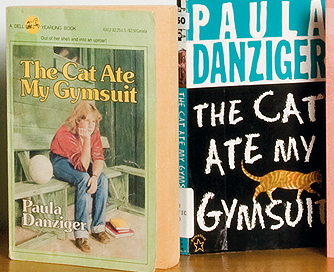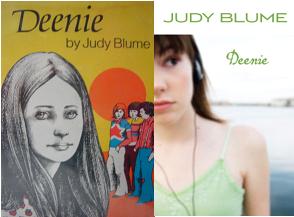The first young adult (YA) novel I ever read that had to do with body image was Judy Blume’s Deenie (1973). In it, 13-year-old Wilmadeen “Deenie” is the “pretty one” of the family, the one whose mother dreams will be a model someday. When Deenie is diagnosed with scoliosis and required to wear a back brace, she struggles with self-image and self-acceptance—worrying that her crush won’t find her attractive, that she will be an object of social ridicule at school, and that she won’t ever get to be a model. Instead, Deenie negotiates a new sense of self, new relationships with her parents and sister, new friendships, and contemplates a career as an orthopedist, realizing that perhaps she never wanted to be a model after all.
For its explicit mentions of masturbation and menstruation, Deenie is one of the most frequently challenged and banned books of all time. But its real radicalism is as an early example of how teen literature can tackle critical issues including body image and body self-acceptance. In other novels, including Blubber (1974) and Are You There, God? It’s Me, Margaret (1970), Blume similarly tells young women’s coming of age stories, and of the accompanying social and environmental pressures therein. (However, in Blume’s Forever (1975), a novel about the first sexual experience, her portrayal of the ultra-thin protagonist is left unexamined, which is soundly critiqued by Beth Younger in her book Learning Curves: Body Image and Female Sexuality in Young Adult Literature.)
 Also published in the same era, Paula Danzinger’s The Cat Ate My Gymsuit (1974) similarly addressed issues of self-image, this time through the point of view of 13-year-old Marcy Lewis, a self-described “baby blimp with wire frame glasses and mousy brown hair.” However, Marcy is more than simply “fat” and her personal growth is vis-à-vis more than just body self-acceptance. As Marcy evolves, she ends up being an activist for change in the small community of her school.
Also published in the same era, Paula Danzinger’s The Cat Ate My Gymsuit (1974) similarly addressed issues of self-image, this time through the point of view of 13-year-old Marcy Lewis, a self-described “baby blimp with wire frame glasses and mousy brown hair.” However, Marcy is more than simply “fat” and her personal growth is vis-à-vis more than just body self-acceptance. As Marcy evolves, she ends up being an activist for change in the small community of her school.
An entire group of current-day YA literature tackles issues of body image, similarly generating controversy. For example, author Laurie Halsie Anderson’s novel Wintergirls (2009), which is written from the point of view of a young woman with severely disordered eating, has caused great uproar among parents and educators. Even the New York Times took up the issue, asking if such a novel—which explicitly discusses extreme exercise, binging, purging, and caloric intake control—is poten tially triggering young women already vulnerable to eating disorders? Can such novels be (mis)used as instruction manuals, yet another source of “thinspiration” for a community of young women already prowling pro-ana and other similar websites?
tially triggering young women already vulnerable to eating disorders? Can such novels be (mis)used as instruction manuals, yet another source of “thinspiration” for a community of young women already prowling pro-ana and other similar websites?
The NYT blog quotes Jack Martin, assistant director of young adult programs at the New York Public Library as saying, “[Laurie Halsie Anderson] does actually reference a lot of the chat rooms that anorexic girls use. It’s researched pretty thoroughly. Wintergirls is a powerful read. It’s so haunting. It’s so horrific I don’t think anybody would pick this book up and consider it a manual.” Yet, Jezebel, an online magazine that offers “Celebrity, sex, and fashion…without airbrushing” suggests,
“Read without discussion or supervision, Wintergirls could indeed be triggering. But read as part of a conversation—or, perhaps, read by parents and other family members—the book could help make some teens’ worlds a little less dark.”
Teen novels are becoming increasingly responsive to readers’ calls to reflect back to them their own lives and their own experiences. There is a growing canon of LGBTQ YA novels, YA novels featuring protagonists of color, YA novels discussing undocumented immigration, dating violence, mental illness, and physical disability. In portraying issues of body image, body harm, and body self-acceptance young adult literature must walk the tightrope between triggering and accurate reflection of teen reality, between articulating problems and contributing to teen girls’ bodies being seen as problems.
Ultimately, each of these books opens conversations, and creates potential safe spaces for dialogue, discussion, self-discovery, and activism.
Other YA books exploring issues of body image include:
Firegirl (2006) by Tony Abbott: What happens to an overweight seventh grade boy when he meets a new classmate with severe burns all over her body?
The Skin I’m In (2007) by Sharon G. Flake: Tall, skinny and dark skinned, 13-year-old Maleeka Madison must discover how to love the body others find to be such a problem.
Big Fat Manifesto (2007) by Susan Vaught: High School senior Jamie is trying to change the world while fighting (not quietly!) for her rights as a very fat girl.
The Fold (2008) by An Na: Should Joyce take her plastic-surgery-loving aunt’s offer to ‘fix’ her eyes so they appear ‘less Asian’?
Zitface (2011) by Emily House: Thirteen-year-old wanna-be actress Olivia’s life seems to fall apart when one pimple turns into a full blown case of acne. Can she find a way back to herself even when everyone calls her ‘Zitface?’
What are your favorite YA novels that address issues of body image and body self-acceptance?

I’ve heard of “I am Jay” but not “Staying Fat for Sarah Byrnes” – thanks for both your recommendations, will definitely look them up! — Sayantani
You should do a review on a great novel I read called I am Jay by Cris Beam
Growing up, J (born as Jennifer) always thought of himself as a boy stuck in the body of a girl. In elementary school J shunned his mom’s attempts to stick him in dresses and preferred the rough-and-tumble play of boys on the playground. Now, as a teenager, J’s Puerto Rican mother and Jewish father want him to think about his future and one day start a family, a possibility that makes J feel misunderstood and anxious about what lies ahead. So after an argument with his best friend, J strikes out on his own. He starts classes at a school for transgender and gay teens, but the complications resulting from who he is and who he wants to be prevent J from truly connecting with anyone. Fed up hiding inside layers of oversized t-shirts, J decides to explore testosterone treatments and embarks on a path that will test his patience, maturity, and commitment.
Its a great novel and she wrote it after volenteering at a school like that for two years where she met her foster Daughter a MTF transgender
Wow, Firegirl sounds like a tepid version of Staying Fat for Sarah Byrnes.
Editor’s Note: http://en.wikipedia.org/wiki/Staying_Fat_for_Sarah_Byrnes